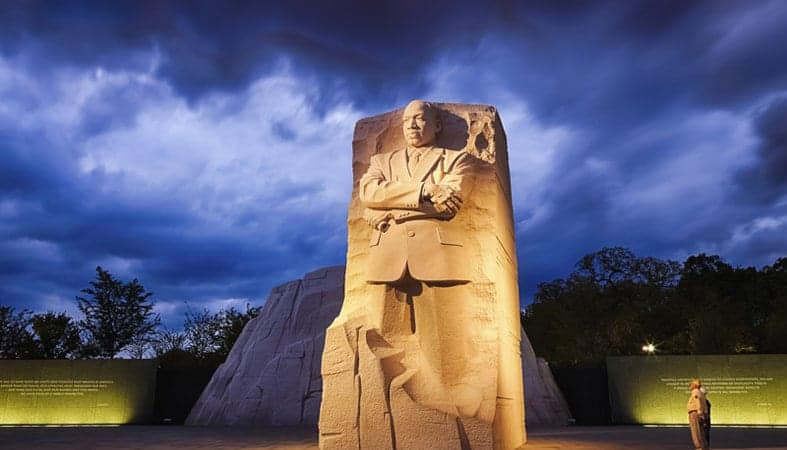February has officially started, which means it is Black History Month! This annual observance is a time to pause and reflect on the contributions that African-Americans have made to American culture. Washington, DC has a very prominent history for black people in America and we are honored to offer our African American History & Culture Tour to share that history with the Capital’s visitors! Additionally, our tour concludes at the newest Smithsonian museum honoring black history in America.
This month is not only about recognizing our past but also about looking to the future so we highlight icons that inspire future generations of young people of color. Before we get there, we wanted to start at the beginning and highlight the history of how we got to now.
Africans were first brought to the New World as slaves when Spanish and Portuguese explorers settled in Central and South America as well as the Caribbean. It is estimated that 275,000 Africans (free and slave) lived in this area by the year 1600.
It wouldn’t be until 1619 that Africans would first arrive in what would later become the United States. One hundred years after Africans were first brought across the Atlantic, over six million Africans lived in North America. Circumstances would remain largely unchanged for blacks in America for generations. Before the American Revolution, slavery was present in every colony. Eventually, the northern states would abandon the practice due to the ideals that were established by America’s Founding Fathers. In the South, however, slavery was highly profitable for tobacco and cotton farmers. It was at this time that the majority of American blacks were located in the South, and nearly all were enslaved.
While there were some attempts by blacks to oppose the harsh treatments inflicted upon them by Southerners, it wasn’t until 1861 when the American Civil War broke out that African-Americans stood a chance at fighting for their freedoms. With it, President Abraham Lincoln ushered in a new age for black Americans with the Emancipation Proclamation, a directive that finally abolished slavery throughout the entirety of the country.

Even after blacks were freed, however, their difficulties continued. Segregation and prejudice would plague the land for nearly a century after slavery ended. It wasn’t until the American civil rights movement that lasted from 1954-1968 that blacks began gaining traction for equal treatment and rights. Figures like Martin Luther King, Jr. helped make tremendous strides for African-Americans and would cement him as a powerful symbol in American culture. What was achieved by the black community (and those who supported them) formed the foundation of our culture’s embrace of inclusion and diversity in modern times.
To begin this month’s duty in commemorating history oft-forgotten we are putting the spotlight on 10 Icons for Black History Month. Scroll down to see our list and check our Instagram @USAGuidedTours for other #BlackHistory content all month long! Contact us to schedule your tour today!
A graduate of Yale Law School, the first black woman to do so, Jane Bolín was a trailblazing attorney who served the state of New York for over six decades. She was sworn into office in New York City as the nation’s first African American female judge – a sight to be seen; Mayor La Guardia even conducted the ceremony at the 1939 World’s Fair. Bolin was a champion for women and children as a judge in the Family Courts of New York, a position she held for forty years.
Jemison’s legacy is truly among the stars and she is one of the few people who has actually been there. A medical doctor, engineer, and astronaut. Jemison was not only NASA’s first African American female recruit into the astronaut training program but also the first black woman to travel to space when she boarded the Endeavour in 1992.
McDaniel started making her name on the Vaudeville circuit and in the Blues in the 20s and she moved into stage and film over the next decade. Her big break finally came in her role as the house servant Mammy in the film classic Gone With the Wind. Despite this, she was barred from attending the film’s premiere in 1939, as all the film’s black actors were. She earned the 1940 Academy Award for Best Supporting Actress and became the first African American to win an Oscar.
Hendrix left an unforgettable mark on the world of music in just a few short years. Though he passed away at the young age of 27 after only five years in the industry, Jimi Hendrix has inspired generations and is remembered as “the ultimate guitarist” for his stage presence and innovative sound. He was inducted into the Rock and Roll Hall of Fame in 1992.
Change will not come if we wait for some other person or some other time. We are the ones we’ve been waiting for. We are the change that we seek.
President Barack Obama, 44th President of The United States of America.
President Obama has been a leader of public service and inspiration his entire career. A graduate of both Columbia University and Harvard Law School, he served on the Illinois State Senate & became a U.S. Senator before being elected for two terms as the 44th President of the United States. He was the first African American to hold the office. He is also the best-selling author and Nobel Peace Prize recipient. When President Barack Obama became the first black leader of the U.S., it created a paradigm shift in what was possible for America’s future.
Robinson became the first black athlete to play in Major League Baseball when he joined the Brooklyn Dodgers in 1947. His recruitment broke the color barrier that had traditionally relegated black athletes to the segregated Negro Leagues. Robinson was named Rookie of the Year his inaugural season, National MVP in 1949, and ultimately became a World Series Champ in 1955.
Gibson was an accomplished athlete who broke color barriers at every stage in her career. She was the first African American to compete in tennis at the U.S. National Championships in 1950 and at Wimbledon a year later. She won the French Open in 1956, Wimbledon in 1957, where she won both the singles & doubles tournament and the U.S. Open in ‘58. By 1960, as one of the World’s biggest tennis stars, she turned to a new challenge: golf. She made history again in that sport – becoming the first black woman to compete on the pro tour.
Johnson was a New York City drag queen and leader in the gay rights movement. She was a vanguard of the protests at NYC’s Stonewall Inn in 1969, a moment remembered every year in Pride festivals around the world. But, as a trans woman of color, Johnson’s influence in the uprising and in LGBTQ+ activism has been overlooked as broader gay movements shifted to the leadership of white cisgender activists in the community. Since her brutal murder in 1992, however, her story has been told in numerous books and documentaries and her legacy has been reinstated and remembered by millennial activists in the LGBTQ+ community.
A track and field athlete who won four gold medals at the 1936 Olympic Games, his long jump record would stand for 25 years. The ‘36 Games took place in Berlin against the backdrop of Nazi Germany and under the leadership of Adolf Hitler himself. Hitler’s policies would lead to the Holocaust a few years later but, in 1936, his doctrines of white supremacy would be fought by black athletes like Owens, scoring medals and breaking two Olympic records. Hitler lambasted America for including black athletes on its Olympic roster. But it was the African American participants who helped cement America’s success at the Olympic Games. In all, the United States won 11 gold medals, six of them by black athletes, four of which were Owens’.
Matthew Henson was an African-American explorer who traveled to much of the world on the high seas at the turn of the 20th century. It was his journey in 1909, however, that has him remembered to this day: an expedition that would have his crew discover the North Pole. As their expedition, backed by Pres. Teddy Roosevelt received scrutiny upon return; his accomplishments were not recognized until years later. He was made an honorary member of the highly-regarded Explorers Club in New York City in 1937 at the age of 70 and received a Congressional Medal in 1944. Years after his death, in 1987, he and his wife were moved and laid to rest at Arlington National Cemetery by President Reagan.
Through tears and triumphs, blacks in the United States have left an enduring mark on the story of our nation. If you find yourself in or near Washington, D.C. this month, sign up to be a part of the African American History & Culture Tour offered by USA Guided Tours. This specialty D.C. bus tour will give you a more in-depth account of the history we have outlined here.
We encourage you to ask your tour guide questions to learn as much as you can about African-American history and how African-Americans have helped form the U.S. into what it is today. We hope you will consider joining us for this special journey so as to more fully appreciate our nation’s history and help build a bright future for the American Dream.
USA Guided Tours Blogging Team

